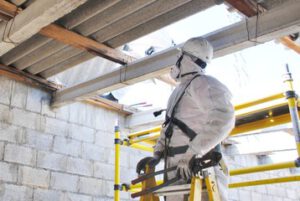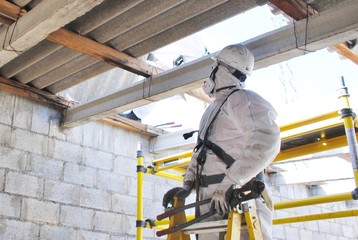Asbestos fibers can be breathed into the lungs and can cause serious health problems, including lung cancer. For this reason, any major repairs and removal must be done by asbestos professionals.
Any material suspected of containing asbestos should be wetted before handling. Any asbestos waste should be double-bagged and enclosed in a decontamination enclosure. Read https://www.perthasbestosremovalwa.com.au/ to learn more.

Before any asbestos abatement work is undertaken, a professional occupational hygienist should be consulted to determine whether the material or area in question is safe to disturb. It is possible to tell if something is asbestos by looking at it, but it cannot be conclusively confirmed without careful laboratory testing. This should be done at a NATA-accredited lab. This is best done by a professional occupational hygienist or licensed asbestos assessor. The cost of the test will vary from one laboratory to the next.
Asbestos is most often found in older buildings and homes. It can be present in insulation materials, shingles, and flooring, as well as in a variety of other household products like drywall compounds, patching, paints, and some gas-fired fireplace and furnace components. Disturbing any of these items can release asbestos fibers into the air, making them a potential health risk for everyone in your home.
The asbestos fibers are incredibly small and can remain airborne for a long time. These tiny particles can penetrate deeply into the lungs and cause respiratory problems and lung cancer. They can also be ingested, where they can lead to stomach problems and other diseases. Some people can even develop heart disease and gastrointestinal problems from exposure to asbestos.
In some cases, you can see if you have asbestos in your home by noticing any physical changes in the structure of the house. If you notice that a room has unusual sagging or a musty smell, it may be contaminated with asbestos.
A professional asbestos abatement contractor should always be used to remove asbestos from a building. They are specially trained in handling the dangerous material, and they have the proper equipment to ensure that the process is carried out safely.
When hiring an asbestos removal company, it is important to make sure that they are properly licensed and insured. It is also a good idea to ask about any federal or state-approved training that the company has undergone. Some local and state health departments or EPA regional offices can provide listings of licensed asbestos professionals in your area.
The best way to determine if asbestos is present in your home or workplace is to have samples taken by an asbestos professional. These professionals are trained, experienced, and reputable. They are also able to offer you cost estimates for sampling, testing, and removal of asbestos materials. Before hiring a professional to work with you, be sure they are licensed in your state and accredited by the National Voluntary Laboratory Accreditation Program (NVLAP).
Many types of residential and commercial building materials contain asbestos. These include floor tiles, sidings, cement, insulators, paints and automotive brakes. These materials are typically referred to as asbestos-containing materials (ACM). ACM may become friable and release fibers into the air if they are disturbed or damaged. Inhalation of these fibers can cause health problems, including respiratory illnesses such as pleural and peritoneal effusion, which is a fluid buildup in the lining of the chest cavity and abdomen. Lung cancer has also been associated with exposure to asbestos.
Asbestos is most hazardous when it becomes airborne. Breathing in asbestos can lead to a variety of diseases including lung cancer, mesothelioma and abdominal scarring. It can also cause fibrosis, which is a thickening and scarring of the lung tissues. The latency period for these diseases ranges from 20 to 30 years, depending on the length of exposure to asbestos and the type of tissue involved.
To avoid inhaling asbestos, it is important to limit the number of people who enter areas containing asbestos. It is also advisable to cover any open areas with heavy plastic and to keep the area closed as much as possible until testing has been completed.
When sampling asbestos, a small amount of material should be removed and placed in an air-tight container. The sample container should then be sealed and labeled with a description of the material, where it was taken and the date. Samples should not be shipped in expanded polystyrene peanuts, vermiculite, or paper shreds, as these interfere with the analysis of asbestos. The samples should be shipped in a package that is cushioned and will not rattle during shipment, such as a cardboard box or a clear plastic bag.
Asbestos is found in a variety of household materials, including textured paint, floor and ceiling tiles, shingles, insulation and pipe lagging. It is a dangerous material, and removing it takes specialized training and equipment that professional abatement contractors have. Hiring a professional is the best and safest way to remove asbestos from a home.
However, many homeowners are curious about whether they can perform their own DIY asbestos removals. Even though there are no federal regulations that prohibit a homeowner from removing asbestos in their own residence, medical and environmental organizations warn against it.
When disturbed, asbestos breaks down into microscopically thin fibers that can become airborne. Once airborne, these fibers can be inhaled by people and pets. Once inhaled, the fibers can lodge in the lungs and cause serious health problems. This includes lung cancer, mesothelioma and other respiratory diseases.
During an asbestos removal, it is important that the contractors work so that as few asbestos fibers as possible become airborne. The contractor should also use a containment system that includes plastic sheets and duct tape to seal off the work area from other parts of the house. The contractor should also turn off the heating and air conditioning system. Finally, the contractor should wet wipe and HEPA vacuum all surfaces within the contained area.
Before hiring a contractor, the homeowner should carefully evaluate each company. Ask the company about their work plans, cleanup procedures, and any applicable local, state, or federal laws governing the removal of asbestos. The homeowner should also get a written contract specifying the work to be done, along with a guarantee that the contractor will follow all applicable regulations.
It is important to note that there is no known safe level of exposure to asbestos, even if it only happens for a few hours during a home renovation project. This is why it’s so important to use body coverings at all times and wear a respirator when working with any material that may contain asbestos.
While it is now possible to convert some types of asbestos into non-toxic materials, these techniques are not yet available to the general public. For this reason, the EPA continues to encourage individuals to hire professional abatement companies to remove or repair any damaged asbestos-containing materials in their homes.
Asbestos-containing materials must be properly disposed of in order to keep them from contaminating the environment. This is especially important because the inhalation of asbestos fibers can cause serious health problems, including mesothelioma cancer and lung diseases such as asbestosis.
As a hazardous material, asbestos is heavily regulated. The Environmental Protection Agency (EPA) requires that asbestos abatement professionals have a special license to do the work. The EPA also regulates how asbestos is handled, transported, and disposed of. This is done to prevent people from trying to perform asbestos removal themselves, which could put them and others at risk of exposure to the dangerous substance.
The EPA’s regulations include establishing protocols to protect workers from exposure and ensuring that the work area is covered, that HVAC systems are turned off, and that warning signs are posted around the work area. Workers must wear a mask, protective clothing, and eyewear to avoid contact with the material. The EPA also requires that workers have training to identify asbestos and how it should be handled safely.
Before removing asbestos-containing materials, workers must ensure that the area is completely sealed off to prevent demolition dust from escaping into adjacent areas of the home or building. This includes sealing windows and exhaust ducts. Once the asbestos abatement work is complete, the EPA will declare the area safe for renovation and construction to resume.
Once asbestos-containing materials have been removed, they must be wetted and placed in leak-proof containers such as plastic bags of 6 mil thickness or higher, cartons, drums, or cans. The waste should be sealed and labeled for transport to a landfill. For bulk waste too large to fit into a container without breaking, the EPA recommends wetting it to minimize the possibility of fibers escaping if the packaging is damaged.
In some cases, a homeowner may be able to take the waste directly to a landfill or transfer station, but they must make sure that the bags are double-bagged and wetted. They must also bring a copy of the waste manifest with their name filled out and signed.

